Home | Front Page | Index | Blog | New | Contact | Site Map
St Augustine
Castillo San Marcos
Miami Beach
Holocaust Memorial
Tallahassee
Gulf Coast
Pensacola
The Rosenzweigs
Gerry's Florida Relatives
Kazers In Florida

Virginia
North Carolina
South Carolina
Georgia
Florida
Alabama
Mississippi
Louisiana
Texas
Arizona
California
Nevada
Index 1999-2002
Index 2003-2004
Index 2005-2006
Index 2007-2008
Index 2009-2011

St Augustine is one of those places every American schoolboy or schoolgirl learns about. As usual in elementary school what you learn is either incomplete, misleading, or just plain wrong. We suppose that the fault is more with the young students than their teachers, but it would be interesting to go back to the text books of 50 years ago and see what they say. We suppose that any errors they had have now been corrected. Or maybe not. Maybe the books would be the victims of modern political correctness and supposed internationalism rather than the earlier nativism.

What is it that we thought we learned? That Ponce de Leon came to Florida in search of the Fountain of Youth and that as a by-product St Augustine, the oldest European settlement in the current USA was founded. There is a bit of truth to this, but as indicated it has more than a little fiction in it.
According to the Encarta "Florida" article "A dubious legend of later years attributed his explorations in Florida to a quest for a magic fountain of youth." However, the same Encarta says in the article about Ponce de Leon that "he heard tales of an island called Bimini, located somewhere north of Cuba, which reputedly possessed the fountain of youth." So who knows whether we were told the truth in elementary school?
And is St Augustine the oldest European settlement in the current USA? No, not if you take it literally, i.e., not unless you add the words "still existing". As it turns out there were several older Spanish settlements, and even a French one, all in Florida, but they were wiped out. In 1564 Fort Caroline was established at the mouth of the St John's River (which runs through modern Jacksonville), about 35 miles north. Working under the principle that might makes right, Spain sent Pedro Menéndez de Avilés to destroy the French colony and found a new city, which he named for St. Augustine, whose saint day it was.
The same destruction started to happen to the Spanish. One of the raiders was our good English friend Sir Francis Drake, whose name we came across in California and Mexico (with reference to Padre Kino's refutation of Drake's claim that Baja California was an island). After St.Augustine had been raided once too often, the Spanish established Castillo de San Marcos to protect the city from the predations of those English pirates.
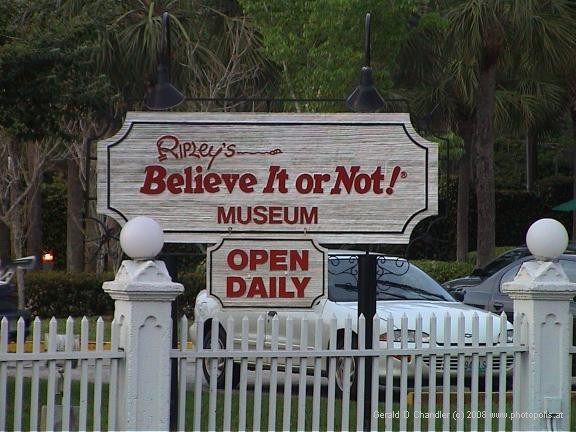
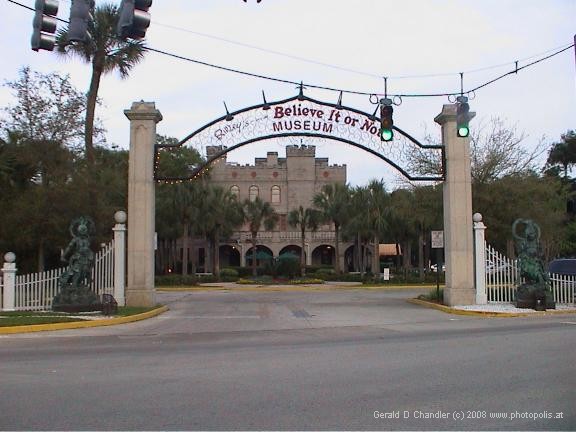
Let us now skip ahead a few hundred years to the St Augustine of today. Like many Florida cities, it is a tourist resort where people come for the sun and the pleasure of spending a little loose change. One place in which to do this is just at the entrance to the tourist district. Ripley's "Believe It or Not" Museums are now found world wide; they are owned by the conglomerate that owns "Madame Tussauds". The one in St Augustine looks cheesy enough that it could have been the first one; memory says that a sign said that. But it wasn't really founded by Ripley. Robert Leroy Ripley (1893-1949) was a sports cartoonist for a New York City newspaper; one day he drew nine cartoons of unbelievable sports occurrences, labeling them "believe it or not" and immediately had a hit on his hand. The museums came later and, we guess, not by his hand.
We missed St Augustine in our first visit together to Florida. That time, in 1985, we flew into and out of Ft Lauderdale, being among the last passengers of low cost Peoples Airlines before it went to the great air storage lot in the sky, and only went to places farther south. This time we drove in from the north and Gerry couldn't possibly pass up checking off one more item on his long list of things to do and places to see.
After a brief glance at the museum we went on to see Castillo San Marcos and then sit and admire the harbor. The place we chose was near the bridge across Matanzas Bay that leads to the light house (which we saw from afar) and Fort Matanzas National Monument, which we hope will be there next time we are around. We shared a set of benches with two drunk drifters. About 50 years old, they looked like they would be bikers if they ever got that much cash in their hands. One of them started a conversation with us but took offense at just about any subject we tried to raise, e.g. "Where you from?" "Don't you think I'm good enough for here." While talking to them we were eating a modest picnic lunch. When they tried to touch us up for some hard cash and we refused, we became the subject of their verbal abuse and soon left to go the short distance into the old town and tourist center.
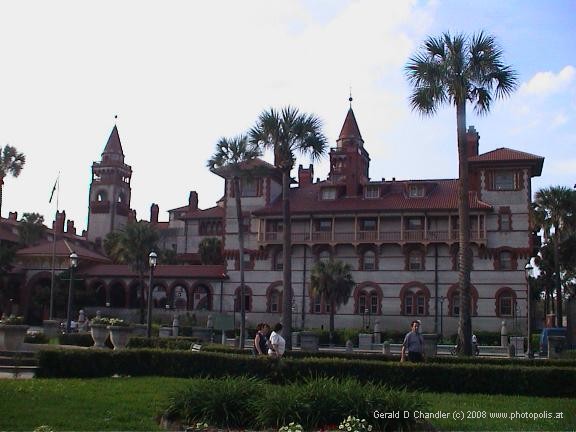
The real force behind modern tourism in St. Augustine's economy was Henry M. Flagler, who in the 1880s started to build a railroad down the coast of Florida and to build hotels and resorts to accompany them. The same system was in effect all over the USA (and probably the world) at that time. For example, the Sante Fe railroad built tracks to the Grand Canyon, hotels on the rim and down in canyon itself. It is not all that different from a modern government like Turkey or Mexico developing a tourist beach destination from scratch: hotel, airport, and all.
St Augustine ended up with the headquarters of the Florida East Coast Railway and several magnificent hotels. We enjoyed walking around and seeing them from the outside and peeking into their lobbies. One of them was converted a hundred years after its construction to a college, named in Flagler's honor. As butlers do with their masters, the students appear to have come to take for granted their fancy surroundings. While we stood awed by the decoration in Ponce de Leon hall (once a hotel lobby) they went by oblivious, books and girl friends in hand.
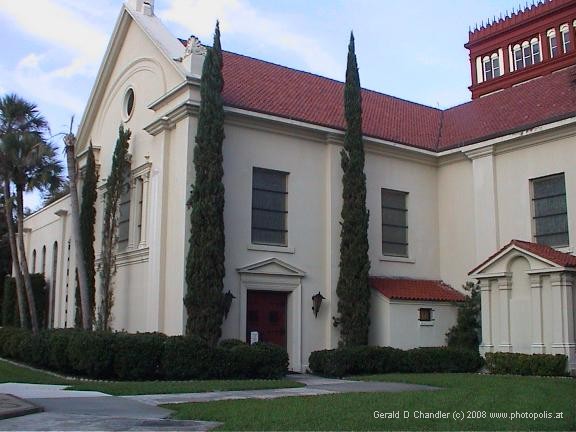

There is a fair number of old and restored buildings around to please the historically minded. We enjoyed seeing the 1791 Cathedral and the five or six old buildings that make up the the Spanish Quarter, a restored 18th-century village. The Oldest House, as it is called, dates to 1723.
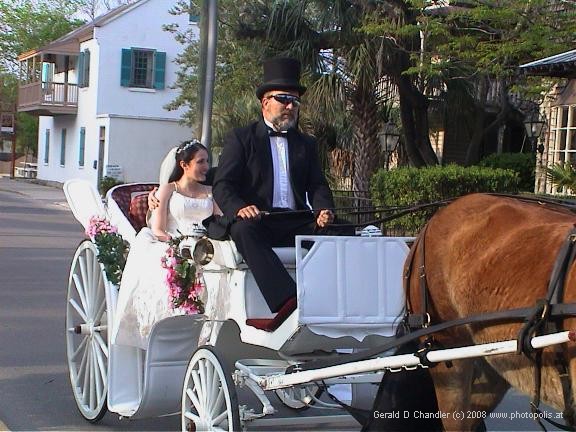

There were plenty of other things that caught our eyes. Why not get married and take a ride in a horse drawn carriage. And then, perhaps, go off on a your honeymoon in a nice antique car? On the other hand, you could find a spot by the water and lay back for a while, or if you're in contemplative mood, admire the Cathedral's beautiful stained glass window that commemorates St. Augustine.

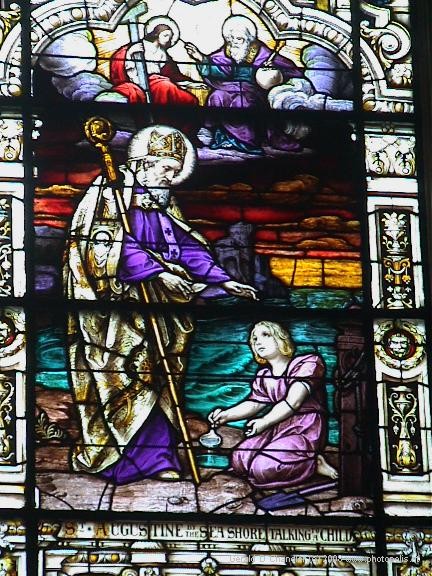
Nativism is a peculiarly American term that refers to the belief among some U.S. native born citizens early in the 20th century that white native born Americans were somehow superior to the hordes of poor immigrants entering the country whether from Europe or Central and South America.